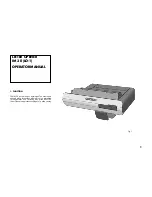
RFHU Operator’s Manual - Shelf Control
12
Electrical shock hazard. Do not wash with water jet or hose.
DO NOT USE CAUSTIC CLEANERS, ACIDS, AMMONIA PRODUCTS OR ABRASIVE CLEANERS
OR ABRASIVE CLOTHS. THESE CAN DAMAGE THE STAINLESS STEEL AND PLASTIC
SURFACES.
Bottom and sides of warmer wells are very hot and cool slowly.
DAILY CLEANING
• Stainless Steel Surfaces
To prevent discoloration or rust on stainless steel
several important steps need to be taken. Stainless
steel contains 70-80% iron which will rust. It
also contains 12-30% chromium which forms an
invisible passive film over the steel surface which
acts as a shield against corrosion. As long as the
protective layer is intact, the metal will not corrode.
If the film is broken or contaminated, outside
elements can begin to breakdown the steel and
begin to form rust or discoloration.
Proper cleaning of stainless steel requires soft
cloths or plastic scouring pads.
Never use steel pads, wire brushes or scrapers.
Cleaning solutions need to be alkaline based or
non-chloride cleaners. Any cleaner containing
chlorides will damage the protective film of the
stainless steel. Chlorides are also commonly found
in hard water, salts and household and industrial
cleaners. If cleaners containing chlorides are used,
be sure to rinse repeatedly and dry thoroughly
upon completion.
Routine cleaning of stainless steel can be done with
soap and water. Extreme stains or grease should
be cleaned with a non-abrasive cleaner and plastic
scrub pad. It is always good to rub with the grain
of the steel. There are also stainless steel cleaners
available which can restore and preserve the finish
of the steels protective layer.
Early signs of stainless steel breakdown can
consist of small pits and cracks. If this has begun,
clean thoroughly and start to apply stainless steel
cleaners in an attempt to restore the passivity of
steel.
NEVER USE AN ACID
BASED CLEANING SOLUTION! MANY
FOOD PRODUCTS HAVE AN ACIDIC
CONTENT WHICH CAN DETERIORATE THE
FINISH. BE SURE TO CLEAN ALL FOOD
PRODUCTS FROM ANY STAINLESS STEEL
SURFACE. COMMON ITEMS INCLUDE,
TOMATOES, PEPPERS AND OTHER
VEGETABLES.
THE POWER MUST BE
TURNED OFF AND DISCONNECTED
AT ALL TIMES WHEN PERFORMING
MAINTENANCE OR REPAIR FUNCTIONS.
NEVER USE A HIGH-PRESSURE
WATER WASH FOR THIS CLEANING
PROCEDURE AS WATER CAN DAMAGE
ELECTRICAL COMPONENTS
ELECTRICAL SHOCK HAZARD.
DO NOT WASH WITH WATER JET OR
HOSE.
RECOMMENDED SUPPLIES
Cleaning Towels
Non-Scratch Scrub Pad
KAY™ Degreaser
KAY® SINK SANITIZER, KAYQUAT™ Sanitizer, or
compatible sanitizer
CLEANING GUIDE


































